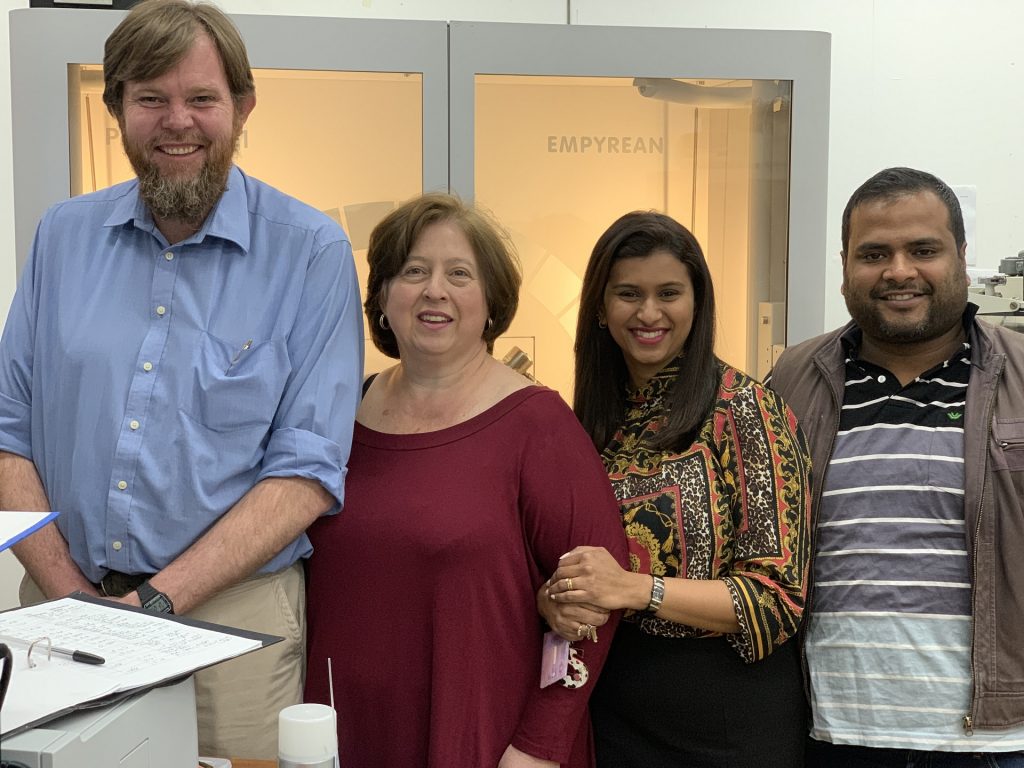Magnetism I
Home » Faculties of Science » Departments » Physics » Research » Condensed Matter »Magnetism in Chromium and Chromium-based alloys in bulk, thin film and nanoparticle form
- Prof ARE Prinsloo (Auckland Park Campus)
- Prof CJ Sheppard (Auckland Park Campus)
- Dr SB Jacobs (Auckland Park Campus)
- Dr P Mohanty (Auckland Park Campus)

Chromium alloy systems exhibit a great variety of interesting antiferromagnetic properties that are associated with nesting of the Fermi surface sheets. The beauty of the properties of these materials originates in their spin-density-wave (SDW) state which contributes a large component, of magnetic origin, to nearly all their physical properties (Rev. Mod. Phys. Vol. 66 (1994)25). What makes these materials more attractive is the fact that, because of the large contribution of SDW origin to their physical properties, once the fundamental role of the SDW in these properties is understood, the physical properties such as for example thermal expansion, resistivity and heat capacity of the alloys can be tailored so that it can be useful in practical applications. Significant innovation will be the role of dimensionality effects in the properties of Cr and its alloys through the studies on magnetic thin films. There is renewed interest in the literature in the physical properties of dilute Cr alloys, particularly in their magnetic phase diagrams and more recently in the quantum critical point effects in dilute Cr alloys, in studies on single crystalline alloys, in their anharmonic effects and in their role as spacer layers in magnetic multilayer thin film structures with giant magnetoresistance properties. The magnetic multilayers are of interest not only for their scientific value, but also since specific magnetic properties can be “designed” in such artificially structured materials.
Our studies are aimed at gaining insight and understanding into the unique effects of the spin-density-wave on the physical properties of chromium and its alloys, both in bulk and thin film forms. It includes investigations of magnetoelasticity and anharmonic effects, Invar and Elinvar properties, electrical transport properties, magnetic susceptibility, specific heat, superconductivity and magnetic phase diagrams of Cr alloys, as well as spin-density-wave effects in Cr alloy thin films and in multilayers with Cr alloy spacer layers. In recent years the group has expanded into the fundamental research on chromite micro- and nanoparticles. This field is rapidly expanding and has promise for applications in water purification and biomedical fields.
The magnetism group has a well-equipped laboratory available for studying magnetic properties of materials, including the following: arc furnace for alloy preparations, crystal growing equipment (Bridgman, Czochralski, floating zone), spark cutting equipment, ultrasonic measuring equipment (phase comparison and pulse-echo-overlap methods) for ultrasonic velocity and attenuation measurements, thermal expansion using strain gauge tecnique, X-ray diffraction equipment for the study of crystallinity and phase, and low to high temperature (4K-1000K) physical measurement platforms t. In addition thin film preparation e-beam apparatus is available. Electron microprobe, XRD, SEM and TEM equipment are available at the Analytical Facility and these are regularly used in our projects. Strong collaboration with Dr Venter makes neutron diffraction studies at Necsa possible.
In addition the Cr Research Group has acquired a NEP(P) Cryogenic Physical Properties Measurement Platform that opens new possibilities in material science and magnetism research. A wide range of physical properties such as electrical resistivity, thermal conductivity, heat capacity, Hall effect and magnetization measurements are possible in temperature ranges from 50 mK to 1200 K and magnetic fields ranging from 0 to mT and then up to 14 T.
Collaboration exists with the following research groups: Prof B Doyle and Prof E Carleschi at University of Johannesburg, South Africa (on XPS measurements); Dr AM Venter at Necsa, South Africa (on neutron diffraction); Dr D Spenato and Dr D Dekadjevi atUniversitė de Occidentale (UBO), France; Prof P de Camargo and Prof A Oliviera at The Federal University of São Carlos (UFSCar) and Prof EE Fullerton at Univeristy of California San Diego (UCSD), USA (on thin magnetic films).
As the studies involve high technology experimental techniques and highly advanced theories in magnetism and physics in general, the level of the research requires the highest academic standards of exceptional quality. Our previously published work on Cr alloys and Cr alloy thin films (see for instance our publications speaks for the high academic standards and quality. The research is ideally suited for training of MSc and PhD students of the highest quality. The high quality of training is attested by the fact that various students involved in this project for presentations and publications emanating from their research work.
